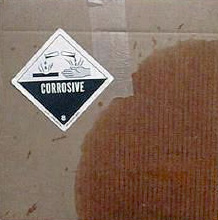- Forms
- Reporting Procedures
- Emergency Information
- Training and Resources
- Helpful Web Links
- Standard Operating Procedures
PROBLEM WITH THIS WEBPAGE?
Report an accessibility problem
To report another problem, please contact sarah.younk@marquette.edu.
Marquette is committed to protecting faculty, staff, students and visitors, as well as the general public and environment from the harmful effects of exposure to hazardous materials and dangerous goods. This can be assured if hazardous material shipments are safely shipped, received and handled so that spills, accidents and exposures are prevented.
Individuals working at Marquette who receive and/or handle hazardous materials shipments are required to be trained in the recognition of hazardous materials and the precautions that should be taken when handling them. This training is available in an on-line format. After review of the training material, please complete the certification exam. Records of employee training will be maintained by the Department of Environmental Health and Safety.
To ensure safe handling, everyone needs to be able to recognize hazardous material because spills happen, and people need to be prepared to respond to them properly. We want to ensure that hazardous material are handled safely.
Hazardous Material is legally defined by class, characteristic and name. The following are some of the materials you may encounter that are considered hazardous:
There are nine categories of hazards used to classify hazardous materials/dangerous goods in transportation. Listed below are common examples of materials that might be received or shipped at Marquette and the hazard class that they are assigned to.
| DOT Hazard Class | Name of Class or Division | Examples of Materials Received |
| Class 1 | Explosives | Azides, Picrates |
| Class 2.1 | Flammable Gas | Acetylene, Butane, Ethylene |
| Class 2.2 | Non-flammable Gas | Argon, Nitrogen, Oxygen |
| Class 3 | Flammable Liquid | Mineral Spirits, Acetone, Acrylonitrile, Hexane, Proponol, Methyl ethyl ketone (MEK) |
| Class 4.1 | Flammable Solid | Paraformaldehyde, Naphthalene |
| Class 4.2 | Dangerous When Wet | Sodium metal, Sodium hydride, Sodium ethoxides, Sodium borohydride, Barium, Chlorotrimethylsilane |
| Class 5.1 | Oxidizer | Ammonium peroxydisulfate, Chromium nitrate, Potassium permaganate, Sodium nitrate |
| Class 5.2 | Organic Peroxide | Methyl ethyl ketone peroxide, Benzoyl peroxide |
| Class 6.1 | Toxic Substances | Phenol, Mercuric Compounds, Potassium Cyanide, Sodium Cyanide |
| Class 6.2 | Infectious Substances | Hepatitis B virus cultures, HIV cultures, Variola virus |
| Class 7 | Radioactive Materials | 32 P-dCTP, 14 C-Bicarbonate, 35S-Methionine |
| Class 8 | Corrosive | Acetic Acid, Sulfuric Acid, Nitric Acid, Formic Acid |
| Class 9 | Miscellaneous Dangerous Goods | Dry Ice, Polymeric beads, Some Batteries, PCB's |
It is important to be able to recognize shipments of hazardous materials. To find out if a shipment includes hazardous materials, look at the shipping paper. Does it have:
Hazardous material must be noted on the shipping paper or bill of lading with highlighting, by being listed first or by being marked with an “X” in the “HM” column.
Not all hazardous material is shipped this way. The regulations exempt small amounts, exempt containers or certain products.
| NOTE: A hazardous material and a non-hazardous material may be placed on the same shipping paper; however, the hazardous material entries must be entered first, or entered in a color that clearly contrasts with any description of a material not subject to the regulations. |
Other indications include:
Hazardous materials received at Marquette via domestic carriers are regulated during transport by the US Department of Transportation. All packages containing more than exempt quantities of hazardous materials will display a diamond shaped DOT label(s) that fall into one or more of 9 hazard classes.
When receiving and signing for hazardous materials these general rules of thumb can be followed:
Examine exterior of all packages before accepting them. If any problems are observable, DO NOT ACCEPT the shipment. Damaged, wet or leaking packages are the responsibility of the transporter.

Call Marquette University Police Department Emergency Response at (414) 288-1911 for:
Refer to the Marquette University Emergency Procedures Guide
Be prepared to provide the following information: